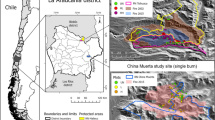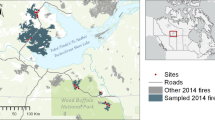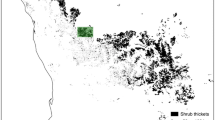Abstract
Changes in community diversity and dynamics after fires in Mediterranean ecosystems are rarely investigated more than a few years after the fire even though pronounced changes can be expected in the longer term due to substitution of canopy species. Pinus halepensis is strongly promoted by wildfire and should therefore be gradually substituted by Quercus species as the time since the last fire increases. We hypothesized that this tree substitution would cause changes in understorey plant diversity by changing resource availability and the abundance and properties of woody debris, leading to changes in biogeochemical processes. To test this hypothesis, we investigated the effect of the time since last fire on vascular plant composition and diversity by studying a 130 years post-fire chronosequence in mixed Mediterranean forests. The canopy composition went from domination by Pinus halepensis to domination by Quercus 70 years after the most recent fire. This transformation was associated with a change in the understorey involving a rarefaction of species present during the first decades after the fire. The plant density or cover also changed with time since the last fire, indicating a succession driven by species rarefaction rather than substitution. The mean richness and Shannon diversity per quadrat were highest shortly after the fire, and were significantly lower 70 or more years after the last fire. Fires are important for supporting highly diversified fire-dependent plant communities, and total plant richness decreases monotonically over time after fires, suggesting that fire suppression may reduce diversity in Mediterranean forests.







Similar content being viewed by others
References
Aedo C, Garcia MA, Alarcon ML, Aldasoro JJ, Navarro C (2007) Taxonomic revision of Geranium subsect. Mediterranea (Geraniaceae). Syst Bot 32:93–128
Baeza MJ, Valdecantos A, Alloza JA, Vallejo VR (2007) Human disturbance and environmental factors as drivers of long-term post-fire regeneration patterns in Mediterranean forests. J Veg Sci 18:243–252
Barbero M, Bonin G, Loisel R, Quezel P (1990) Changes and disturbances of forest ecosystems caused by human activities in the western part of the Mediterranean basin. Vegetatio 87:151–173
Barbero M, Loisel R, Quézel P, Richardson D, Romane F (1998) Pines of the Mediterranean basin. In: Richardson DM (ed) Ecology and biogeography of Pinus. Cambridge University Press, Cambridge, pp 153–170
Bates D, Sarkar D (2007) lme4: Linear mixed-effects models using S4 classes. R package version 0.999375-37. https://CRAN.R-project.org/package=lme4
Bond WJ, Keeley JE (2005) Fire as a global ‘herbivore’: the ecology and evolution of flammable ecosystems. TREE 20:387–394
Bond WJ, Van Wilgen BW (1996) Fire and plants. Chapman & Hall, London
Capitanio R, Carcaillet C (2008) Post-fire Mediterranean vegetation dynamics and diversity: a discussion of succession models. For Ecol Manag 255:431–439
Carter ZW, Sullivan BW, Qualls RG, Blank RR, Schmidt CA, Verburg PSJ (2018) Charcoal increases microbial activity in eastern Sierra Nevada forest soils. Forests 9:93. https://doi.org/10.3390/f9020093
Carvalho A, Carvalho CA, Martins H, Marques C, Rocha A, Borrego C, Viegas DX, Miranda AI (2011) Fire weather risk assessment under climate change using a dynamical downscaling approach. Environ Model Softw 26:1123–1133
Cespedes B, Torres I, Luna B, Perez B, Moreno JM (2012) Soil seed bank, fire season, and temporal patterns of germination in a seeder-dominated Mediterranean shrubland. Plant Ecol 213:383–393
Chauchard S, Carcaillet C, Guibal F (2018) Fir expansion not controlled by moderate densities of large herbivores: a Mediterranean mountain grassland conservation issue. Ann For Sci 75(4):94. https://doi.org/10.1007/s13595-018-0774-y
Cherubini P, Gartner BL, Tognetti R, Braker OU, Schoch W, Innes JL (2003) Identification, measurement and interpretation of tree rings in woody species from Mediterranean climates. Biol Rev 78:119–148
Clements FE (1916) Plant succession: an analysis of the development of vegetation. Carnegie Institute Publication 242, Washington DC
Collins SL, Glenn SM, Gibson DJ (1995) Experimental analysis of intermediate disturbance and initial floristic composition: decoupling cause and effect. Ecology 76:486–492
Connell JH (1978) Diversity in tropical rain forests and coral reefs. Science 199:1302–1310
Connell JH, Slatyer RO (1977) Mechanisms of succession in natural communities and their role in community stability and organization. Am Nat 111:1119–1144
Cramer W, Guiot J, Fader M, Garrabou J, Gattuso JP, Iglesias A, Lange MA, Lionello P, Llasat MC, Paz S, Peñuelas J, Snoussi M, Toreti A, Tsimplis MN, Xoplak E (2018) Climate change and interconnected risks to sustainable development in the Mediterranean. Nat Clim Chang 8:972–980
Cruz-Alonso V, Villar-Salvador P, Ruiz-Benito P, Ibanez I, Rey-Benayas JM (2019) Long-term dynamics of shrub facilitation shape the mixing of evergreen and deciduous oaks in Mediterranean abandonned field. J Ecol. https://doi.org/10.1111/1365-2745.13309
Daskalakou EN, Thanos CA (2010) Postfire seedling dynamics and performance in Pinus halepensis Mill. populations. Acta Oecol 36:446–453
Davis RA, Doherty TS, van Etten EJB, Radford JQ, Holmes F, Knuckey C, Davis BJ (2016) Conserving long unburnt vegetation is important for bird species, guilds and diversity. Biodivers Conserv 25:2709–2722
Debussche M, Lepart J (1992) Establishment of woody-plants in Mediterranean old field—opportunity in space and time. Landsc Ecol 6:133–145
DeLuca TH, Sala A (2006) Frequent fire alters nitrogen transformations in ponderosa pine stands of the inland northwest. Ecology 87:2511–2522
Duncan R (1989) An evaluation of errors in tree age estimates based on increment cores in kahikatea (Dacrycarpus dacrydioides). N Z Nat Sci 16:1–37
Egler FE (1954) Vegetation science concepts I. Initial floristic composition, a factor in old-field vegetation development. Vegetatio 4:412–417
Fernandes PM, Davies G, Ascoli D, Fernandez C, Moreira F, Rigolot E, Stoof CR, Vega JA, Molina D (2013) Prescribed burning in southern Europe: developing fire management in a dynamic landscape. Front Ecol Environ 11:e4–e14
Fortuny X, Carcaillet C, Chauchard S (2014) Land use legacies and site variables control the understorey plant communities in Mediterranean broadleaved forests. Agric Ecosyst Environ 189:53–59
Fortuny X, Carcaillet C, Chauchard S (2020) Selective and taxon-dependent effects of semi-feral cattle grazing on tree regeneration in an old-growth Mediterranean mountain forest. For Ecosyst 7:11. https://doi.org/10.1186/s40663-020-00222-7
Fournier T, Battipaglia G, Brossier B, Carcaillet C (2013) Fire-scars and polymodal age-structure provide evidence of fire-events in an Aleppo pine population in southern France. Dendrochronologia 31:159–164. https://doi.org/10.1016/j.dendro.2013.05.001
Fournier TP, Brossier B, Gauthier O, Carcaillet C (2012) Post-fire dynamics and spatial heterogeneity of woody debris associated with Pinus halepensis in an oak-pine Mediterranean ecosystem. Ecoscience 19:356–363. https://doi.org/10.2980/19-4-3502
Fréjaville T, Curt T (2017) Seasonal changes in the human alteration of fire regimes beyond the climate forcing. Environ Res Lett 12:035006. https://doi.org/10.1088/1748-9326/aa5d23
Garnier E et al (2004) Plant functional markers capture ecosystem properties during secondary succession. Ecology 85:2630–2637
Giorgi F, Lionello P (2008) Climate change projections for the Mediterranean region. Glob Planet Change 63:90–104
Gonzalez-De Vega S, de las Heras J, Moya D (2019) Post-fire regeneration and diversity response to burn severity in Pinus halepensis Mill. forests. Forests 9:299. https://doi.org/10.3390/f906029
Gosper CR, Yates CJ, Prober SM (2013) Floristic diversity in fire-sensitive eucalypt woodlands shows a ‘U’-shaped relationship with time since fire. J Appl Ecol 50:1187–1196
Gotellli NJ, Colwell RK (2001) Quantifying biodiversity: procedures and pitfalls in measurement and comparison of species richness. Ecol Lett 4:379–391
Gracia M, Retana J, Roig P (2002) Mid-term successional patterns after fire of mixed pine-oak forests in NE Spain. Acta Oecol 23:405–411
Grime JP (1977) Evidence for the existence of three primary strategies in plants and its relevance to ecological and evolutionary theory. Am Nat 111:1169–1194
Grime JP (1998) Benefits of plant diversity to ecosystems: immediate, filter and founder effects. J Ecol 86:902–910
Grissino-Mayer HD (2001) Evaluating crossdating accuracy: a manual and tutorial for the computer program COFECHA. Tree-Ring Res 57:205–221
Guo QF (2001) Early post-fire succession in California chaparral: Changes in diversity, density, cover and biomass. Ecol Res 16:471–485
Hattenschwiler S, Vitousek PM (2000) The role of polyphenols in terrestrial ecosystem nutrient cycling. TREE 15:238–242
Hernandez-Serrano A, Verdu M, Santos-del-Blanco L, Climent J, Gonzalez-Martinez SC, Pausas JG (2014) Heritability and quantitative genetic divergence of serotiny, a fire-persistence plant-trait. Ann Bot 114:571–577
Hinojosa MB, Laudicina VA, Parra A, Albert-Belda E, Moreno JM (2019) Drought and its legacy modulate the post-fire recovery of soil functionality and microbiobial community structure in a Mediterranean shrubland. Glob Change Biol 25:1409–1427
Jacquet K, Prodon R (2009) Measuring the post-fire resilience of a bird-vegetation system: a 28-year study in a Mediterranean oak woodland. Oecologia 161:801–811
Johnson EA, Miyanishi K (2008) Testing the assumptions of chronosequences in succession. Ecol Lett 11:419–431
Kazanis D, Arianoutsou M (2004) Long-term post-fire vegetation dynamics in Pinus halepensis forest of Central Greece: a functional group approach. Plant Ecol 171:101–121. https://doi.org/10.1023/B:VEGE.0000029376.15741.b4
Knox KJ, Clarke PJ (2006) Fire season and intensity affect shrub recruitment in temperate sclerophyllous woodlands. Oecologia 149:730–739
Kouba Y, Camarero JJ, Alados CL (2012) Roles of land-use and climate change on the establishment and regeneration dynamics of Mediterranean semi-deciduous oak forests. For Ecol Manag 274:143–150
Kurth VJ, Hart SC, Ross CS, Kaye JP, Fulé PZ (2014) Stand-replacing wildfires increase nitrification for decades in southwestern ponderosa pine forests. Oecologia 175:395–407
Lavorel S, Garnier E (2002) Predicting changes in community composition and ecosystem functioning from plant traits: revisiting the Holy Grail. Funct Ecol 16:545–566
Lazarina M, Devalez J, Neokosmidis L, Sgardelis SP, Kallimanis AS, Tscheulin T, Tsalkatis P, Kourtidou M, Mizerakis V, Nakas G, Palaiologou P, Kalabodikis K, Vujic A, Petanidou T (2019) Moderate fire severity is best for the diversity of most of the pollinator guilds in Mediterranean pine forests. Ecology 100:e02615
Mackey RL, Currie DJ (2001) The diversity-disturbance relationship: is it generally strong and peaked? Ecology 82:3479–3492
Magurran AE (1988) Ecological diversity and its measurement. Princeton University Press, Princeton
Moritz MA, Parisien MA, Batllori E, Krawchuck MA, Van Dorn J, Ganz DJ, Hayhoe K (2012) Climate change and disruptions to global fire activity. Ecosphere 3:49. https://doi.org/10.1890/ES11-00345.1
Moya D, Gonzalez-De Vega S, Garcia-Orenes F, Morugan-Coronado A, Arcenegui V, Mataix-Solera J, Lucas-Borja ME, De las Heras J (2018) Temporal characterisation of soil-plant natural recovery related to fire severity in burned Pinus halepensis Mill. forest. Sci Total Environ 640:41–52
Mouillot F, Rambal S, Joffre R (2002) Simulating climate change impacts on fire frequency and vegetation dynamics in a Mediterranean-type ecosystem. Glob Change Biol 8:423–437
Navarro LM, Pereira HM (2012) Rewilding abandonned landscapes in Europe. Ecosystems 15:900–912
Niklasson M, Zin E, Zielonka T, Feijen M, Korczyk AF, Churski M, Samo-jlik T, Jedrzejewska B, Gutowski JM, Brzeziecki B (2010) A 350-year tree-ring fire record from Bialowieza primeval forest, Poland: implications for Central European lowland fire history. J Ecol 98:1319–1329
Pal JS, Giorgi F, Bi XQ (2004) Consistency of recent European summer precipitation trends and extremes with future regional climate projections. Geophys Res Lett 31:L13202
Panaïotis C, Carcaillet C, M’Hamedi M (1997) Determination of the natural mortality age of an holm oak (Quercus ilex L.) stand in Corsica (Mediterranean Island). Acta Oecol 18:519–530
Pausas JG (2004) Changes in fire and climate in the eastern Iberian Peninsula (Mediterranean basin). Clim Change 63:337–350
Pausas JG, Fernandez-Munoz S (2011) Fire regime changes in the Western Mediterranean Basin: from fuel-limited to drought-driven fire regime. Clim Change 110:215–226
Pausas JG, Llovet J, Rodrigo A, Vallejo R (2008) Are wildfires a disaster in the Mediterranean basin? A review. Int J Wildland Fire 17:713–723
Pausas JG, Ouadah N, Ferran A, Gimeno T, Vellejo R (2003) Fire severity and seedling establishment in Pinus halepensis woodlands, eastern Iberian Peninsula. Plant Ecol 169:205–213
Perez-Valera E, Verdu M, Navarro-Cano JA, Goberna M (2018) Resilience to fire of phylogentic diversity across biological domains. Mol Ecol 27:2896–2908
Pickett STA, White PS (1985) The ecology of natural disturbance and patch dynamics. Academic Press, New York
Pons A, Quézel P (1998) On the installation of the Mediterranean climate. C R Acad Sci Terre Planet 327:755–760
R Team (2013) R: a language and environment for statistical computing. R Foundation for Statistical Computing, Vienna
Retana J, Espelta JM, Habrouk A, Ordonez JL, de Sola-Morales F (2002) Regeneration patterns of three Mediterranean pines and forest changes after a large wildfire in northeastern Spain. Ecoscience 9:89–97
Risberg L, Granström A (2014) Exploiting a window in time: fate of recruiting populations of two rare fire-dependent Geranium species after forest fire. Plant Ecol 215:613–624
Schweingruber FH (1988) Tree rings-basics and applications of dendrochronology. Reidel Publishing Company, Dordrecht
Serre-Bachet F (1992) Les enseignements écologiques de la variation de l’épaisseur du cerne chez le pin d’Alep. Forêt Mediterranéenne 13:171–176
Shannon CE (1948) A mathematical theory of communication. Bell Syst Technol J 27:379–423
Sheffield J, Wood EF (2008) Projected changes in drought occurrence under future global warming from multi-model, multi-scenario, IPCC AR4 simulations. Clim Dyn 31:79–105
Simioni G, Marie G, Davi H, Martin-St Paul N, Huc R (2020) Natural forest dynamics have more influence than climate change on the net ecosystem production of a mixed Mediterranean forest. Ecol Model 416:108921
Stokes MA, Smiley TL (1996) An introduction to tree-ring dating. University of Arizona Press, Tucson
Tatoni T, Roche P (1994) Comparison of old-field and forest revegetation dynamics in Provence. J Veg Sci 5:295–302
Taudière A, Bellanger JM, Moreau PA, Carcaillet C, Christophe A, Læssøe T, Panaïotis C, Richard F (2017a) Xylobolus subpileatus, a hyper-specialized basidiomycete functionally linked to old canopy gaps. Can J For Res 47:965–973. https://doi.org/10.1139/cjfr-2016-0521
Taudière A, Richard F, Carcaillet C (2017b) Review on fire effects on ectomycorrhizal symbiosis, an unachieved work for a scalding topic. For Ecol Manag 391:446–457
Tedim F, Leone V, Xanthopoulos G (2016) A wildfire risk management concept based on a social-ecological approach in the European Union: fire smart territory. Int J Disaster Risk Reduct 18:138–153
Ter Braak CJF (1986) Canonical correspondence analysis: a new eigenvector technique for multivariate direct gradient analysis. Ecology 67:1167–1179
Thanos CA, Daskalakou EN (2000) Reproduction in Pinus halepensis and P. brutia. In: Ne’eman G, Trabaud L (eds) Ecology, biogeography and management of Pinus halepensis and P. brutia forest ecosystems in the Mediterranean basin. Backhuys Publishers, Leiden, pp 79–90
Thanos CA, Daskalakou EN, Nikolaidou S (1996) Early post-fire regeneration of a Pinus halepensis forest on Mount Parnis, Greece. J Veg Sci 7:273–280
Thuiller W, Lavorel S, Araujo MB, Sykes MT, Prentice IC (2005) Climate change threats to plant diversity in Europe. PNAS 102:8245–8250
Tsafrir A, Osem Y, Shemesh H, Carmel Y, Soref C, Ovadia O (2019) Fire season modifies the perennial plant composition through a differential effect on obligate seeders in eastern Mediterranean woodlands. Appl Veg Sci 22:115–126
Trabaud L (1987) Dynamics after fire of sclerophyllous plant communities in the Mediterranean basin. Ecol Mediterr 13:25–37
Trabaud L (2000) Post-fire regeneration of Pinus halepensis forests in the West Mediterranean. In: Ne’eman G, Trabaud L (eds) Ecology, biogeography and management of Pinus halepensis and P brutia forest ecosystems in the Mediterranean basin. Backhuys Publishers, Leiden, pp 257–268
Walker LR, Wardle DA, Bardgett RD, Clarkson BD (2010) The use of chronosequences in studies of ecological succession and soil development. J Ecol 98:725–736
Acknowledgements
Financial support was provided by the FIREMAN programme (ERA-net BiodivERsA, ANR-08-BDVA-0004) to CC. We warmly thank Julie Aleman, Giovanna Battipaglia, Loïc Bircker, Laurent Bremond, Benoit Brossier, Xavier Fortuny, Olivier Gauthier, Sarah Ivorra, Bérangère Leys, Shane McCloskey, Laure Paradis, Sandrine Picq, Paul Roiron and Sandrine Subitani for their help during the fieldwork and the tree-ring analyses. We especially thank Raimondo Capitanio, who sampled five sites by himself while working on his Master’s thesis. The English text was edited by SEES-Editing Ltd.
Author information
Authors and Affiliations
Contributions
CC (PhD supervisor) and TF (PhD student) designed the study inspiring by the Capitanio and Carcaillet’s study (2008); TF and JF (MSc student) carried out the fieldwork and collected the data; JF identified plants. TF analyzed the data, and wrote the first draught as a chapter of his PhD thesis, but abandoned in 2013 after his PhD viver. CC edited the first draught to transform it in a research article and carried out the bibliographic watch. FC contributed for the statistics and to edit the manuscript. CC and FC approved the final version.
Corresponding author
Ethics declarations
Conflict of interest
The authors declare no conflict of interest.
Additional information
Communicated by Carissa Lyn Wonkka.
Publisher's Note
Springer Nature remains neutral with regard to jurisdictional claims in published maps and institutional affiliations.
Electronic supplementary material
Below is the link to the electronic supplementary material.
Rights and permissions
About this article
Cite this article
Fournier, T., Fèvre, J., Carcaillet, F. et al. For a few years more: reductions in plant diversity 70 years after the last fire in Mediterranean forests. Plant Ecol 221, 559–576 (2020). https://doi.org/10.1007/s11258-020-01034-z
Received:
Accepted:
Published:
Issue Date:
DOI: https://doi.org/10.1007/s11258-020-01034-z




